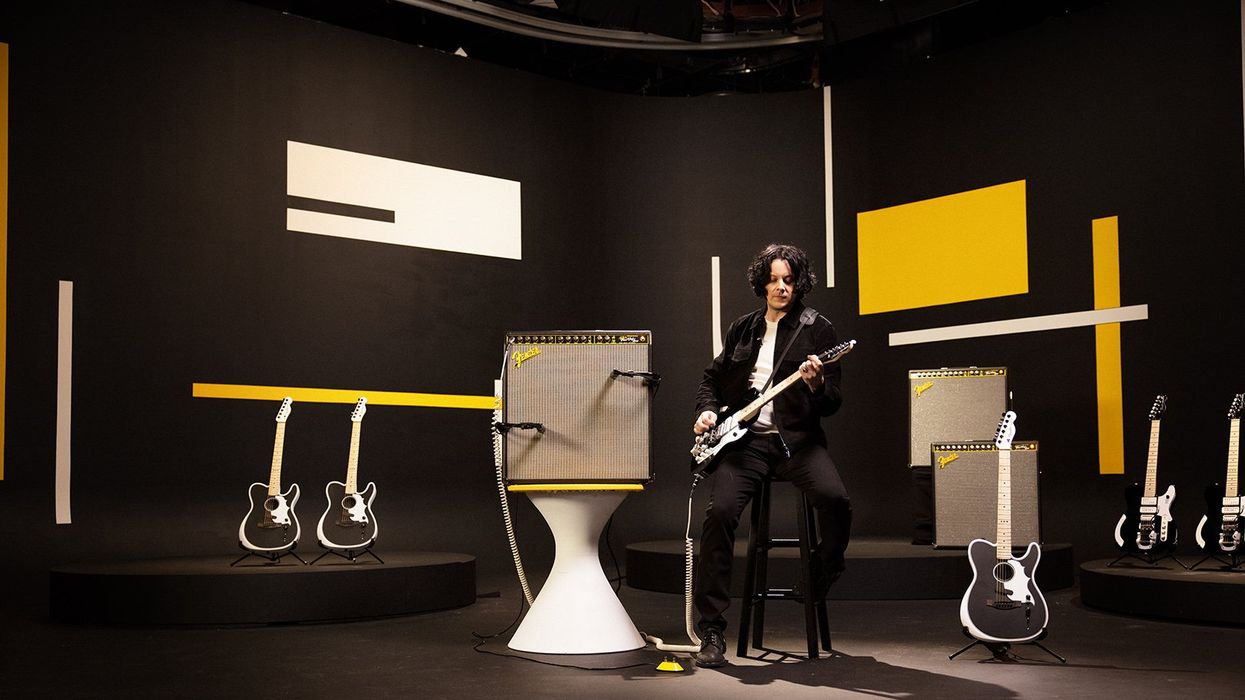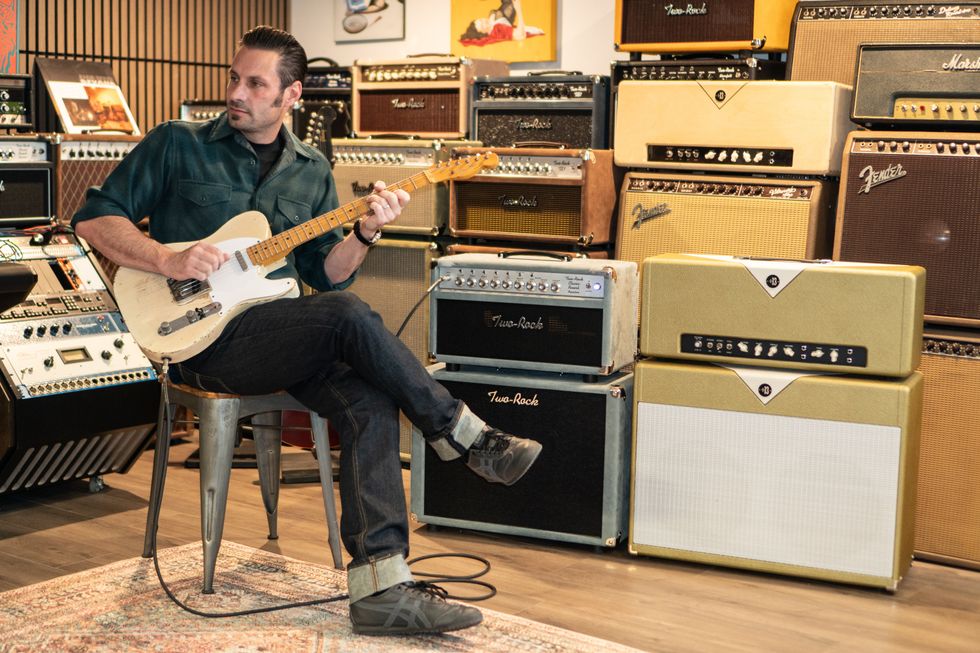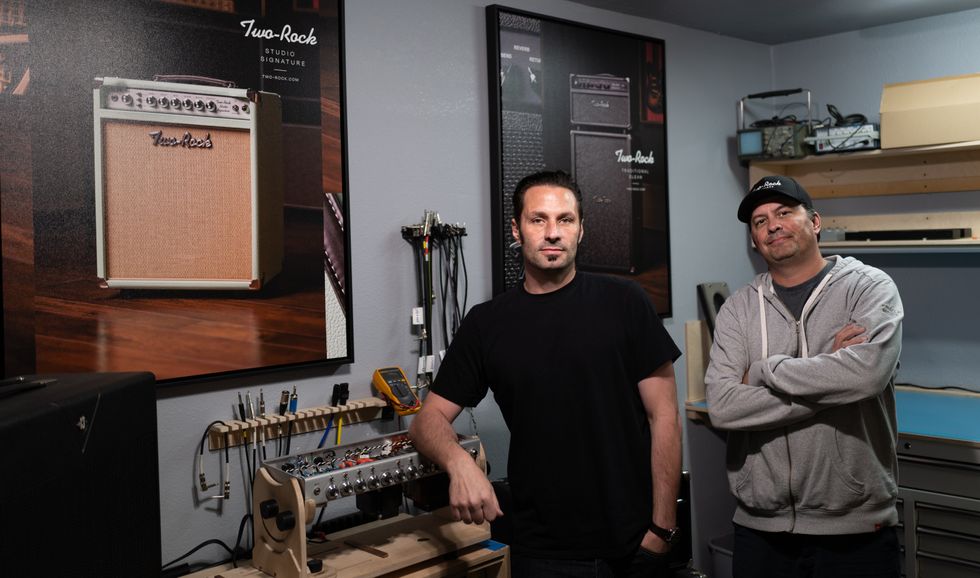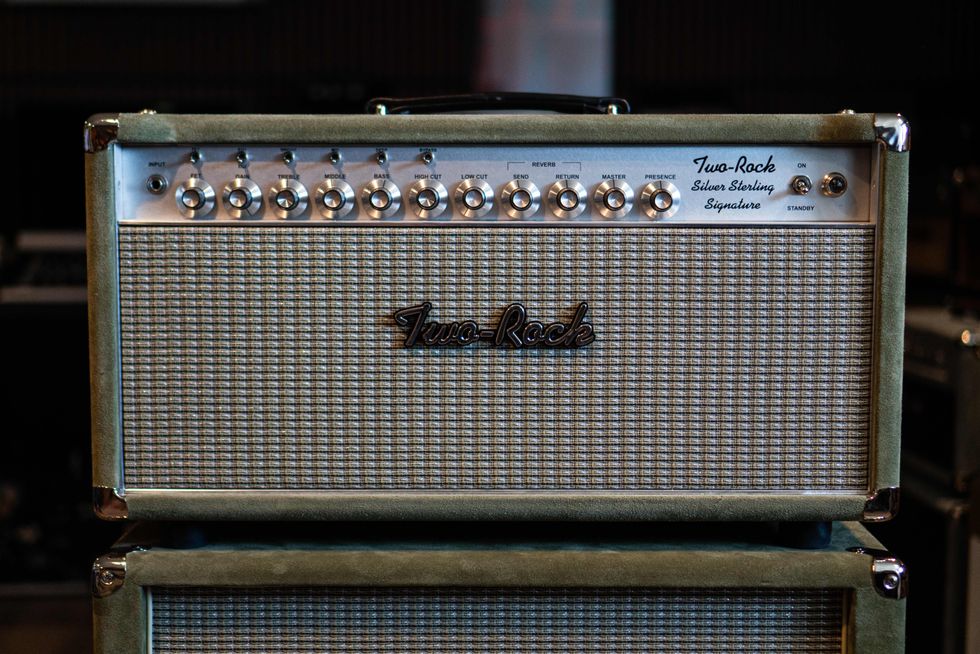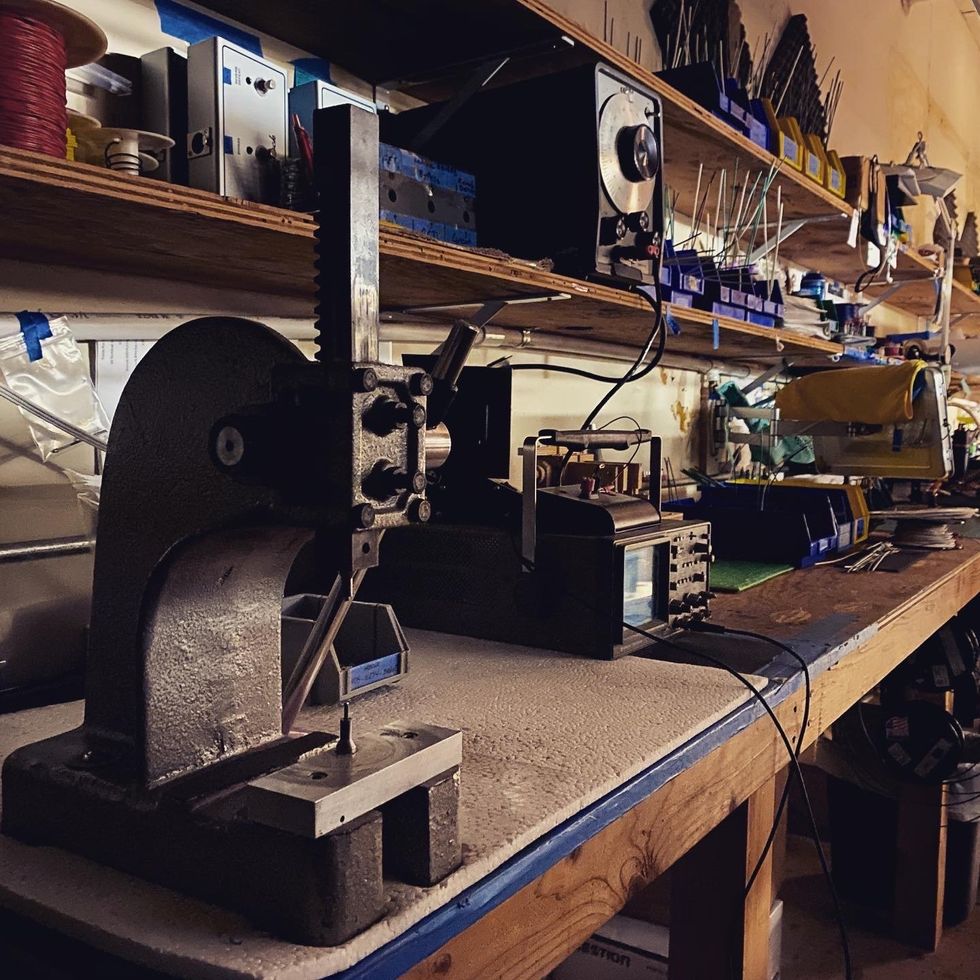This week, Fender and Jack White dropped a new line that spun heads across the guitar-gear universe, proving that the Third Man’s brain knows no bounds. White has been blowing minds with Third Man Hardware’s line of collaboratively conceived gear. Working with makers of all sizes, each yellow-and-black piece is as unique as White himself.
Hooking up with Fender for the Jack White Signature Collection—which includes the Signature model hot-rod Jack White TripleCaster Telecaster and the stunning Jack White TripleSonic Acoustasonic—is as big as it gets, and this week’s announcement is proportionately epic.
The all-new Jack White Pano Verb amp looks to be one of the most forward-thinking advances in tube amps we’ve seen in … well, a very long time! Although it’s roughly inspired by three vintage Fender models—a 1964 Vibroverb, a 1960 Vibrasonic, and a 1993 Vibro-King—the Pano Verb is a rare all-new design that is poised to thrill. The single-channel stereo amp delivers 70 watts of combined power and features stereo harmonic tremolo and stereo reverb circuits, with unique routing options through the hip pair of 15" and 10" speakers. If you haven’t checked out Fender’s video announcing the amp, prepare to have your mind blown by the possibilities.
“It wasn’t based on what we could or couldn’t do, or what even was or wasn’t possible. It was just what Jack was looking to accomplish.”
Fender Vice President of Research and Development Stan Cotey, who worked closely with White to develop the prototypes for the Pano Verb, says, “There were no restrictions as far as how wild something could be. It wasn’t based on what we could or couldn’t do or what even was or wasn’t possible. It was just what Jack was looking to accomplish.” Putting those goals into action was a kick for Cotey. “I love the fact that we’re still pushing the idea of vacuum tubes and that there are things remaining to be done,” he says. “And [the Pano Verb] is a really crazy thing. It’s fun when one of the larger companies tackles a big crazy thing and releases it in a bold manner.”
We rang up Cotey to get the scoop on designing the amp as we wait to get our hands on one.
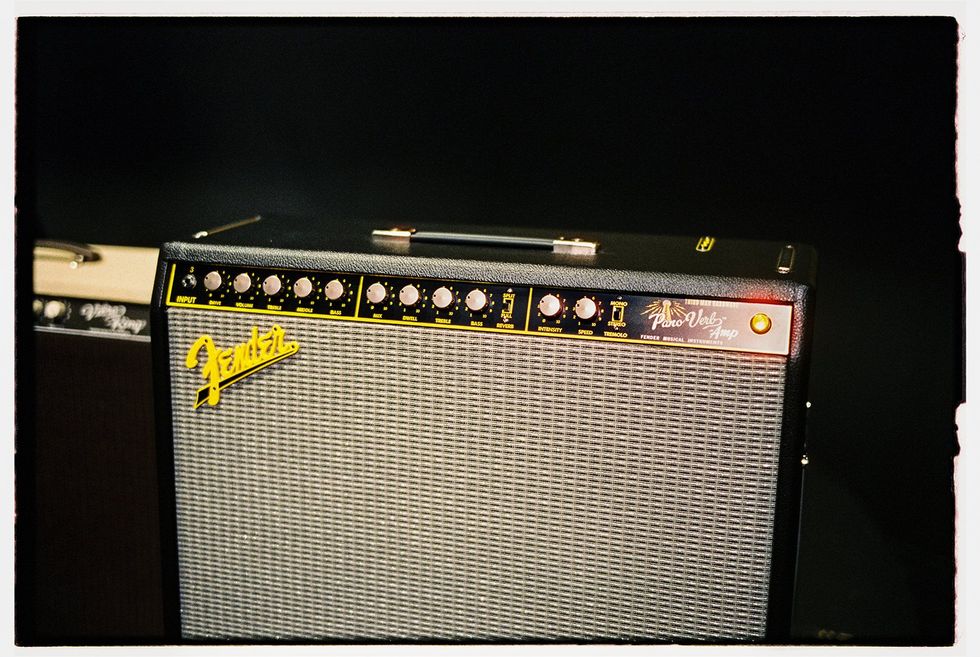
Cotey calls the Pano Verb “a really crazy thing,” and says, “It’s fun when one of the larger companies tackles a big crazy thing and releases it in a bold manner.”
The Pano Verb has a refreshingly unique and adventurous set of features.
Stan Cotey: There’s two separate power amps, there’s two separate preamps, there’s a reverb circuit. There are two separate harmonic vibrato circuits. There’s two full, separate amps in it—there’s one power supply, but everything else, there’s at least two of.
There are several different kinds of stereo interaction that could happen. The harmonic vibrato could be stereo. The reverb, even though it’s a mono tank, could be steered to the speakers differently, which kind of gives a stereo-imaging thing. So, that opens up myriad possibilities for how things could work.
How involved was Jack in the design?
Cotey: He was completely hardcore. He cared in great detail, exactly down to fine decimal points, how it worked. He was very particular about the voicing. He was very particular about the features he knew. He’s pretty studio savvy, so he had a sense of routing, how he wanted the stereo interaction of the sections to work together. He very much had an idea of stereo-ness for the amp at the outset of it. He talked early on about miking both speakers and panning them—he wanted to be able to do sort of startling things with each speaker’s content.
I think my role was to take the stuff that he wanted to do and figure out how we could do it. So, the stereo-ness of the amp, the 10" speaker versus the 15" speaker, the routing stuff you could do where the reverb goes to one speaker or both, all that stuff came from Jack.
Jack’s Vibrasonic was a touchstone for the Pano Verb.
Cotey: That amp lived with me for quite a while. He knew that he liked the harmonic tremolo.
The stereo harmonic tremolo, that’s a fairly part-intensive circuit, even in a normal brown amp. In this amp, there’s two full circuits in it, so it is literally double the parts of one of the more complicated earlier ’60s amps, just for that part of the amp. I worked out how that works. That’s two harmonic tremolos that are in sync, but opposite polarity. So, when one’s going up, the other is going down, and vice versa.
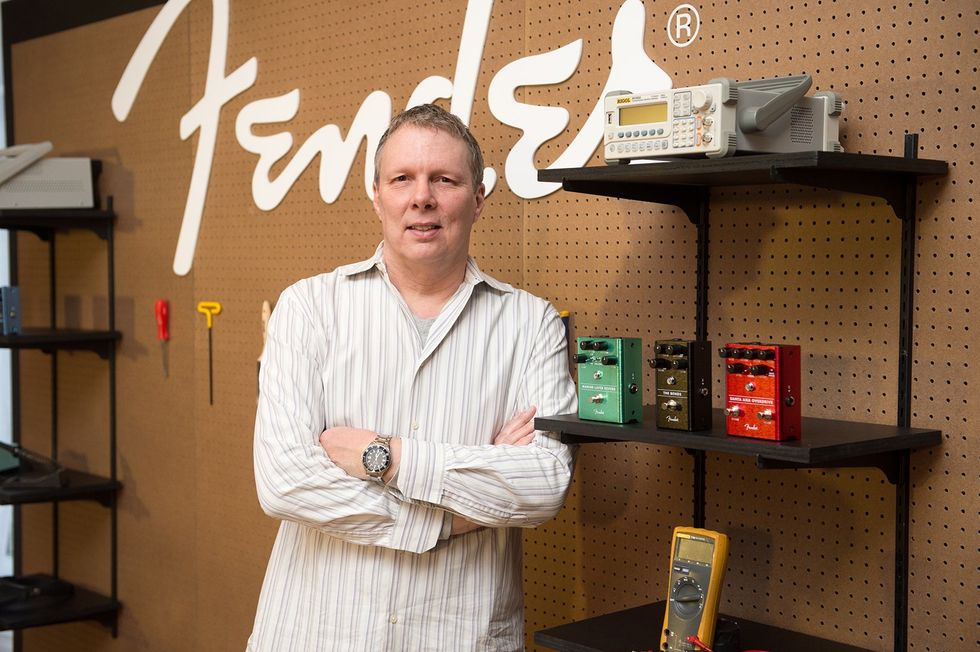
Stan Cotey is Fender’s Vice President of Guitar Research and Development and worked with White to design the prototypes for the Pano Verb.
The reverb mix on the Pano Verb is rooted in some vintage designs, but it’s handled a little differently here.
Cotey: In the video, he talked about the reverb tank in front of the amp, which forms the Vibro-King, and that he liked the idea. I think he liked the idea of having a more comprehensive, dedicated reverb circuit in an amp, not where it’s just kind of spread on the top, like margarine or something.
In a traditional Fender amp, there’s a feed that comes off the preamp circuit that goes to a driver, which is a tube and a little transformer, and that drives the reverb tank. Then, the output of the reverb tank goes into a recovery amp, a little gain stage with a tube, and that gets mixed with the output of the channel and shoved into the power amp. So, the reverb kind of occurs between the preamp and the power amp. It largely takes the tonality of the preamp on because the tone controls are upstream of it.
Jack has an old Fender amp from the early ’60s that had reverb added. I don’t know who modified it, but they actually used the second channel of the amp as the reverb return, which I think is really super clever. Then you get tone controls for the reverb. So that’s where that idea came from. He didn’t necessarily want the reverb circuit in front. He liked it between the preamp and the power amp, but he wanted to have it be more comprehensive than what would be on a typical mid-’60s Fender amplifier.
What was the most exciting feature for you to create?
The stereo harmonic tremolo was really fun, and the journey that we went on to get there was really cool. I have a tweed amp from the late ’50s from Guild that has tremolo in it, and it’s a stereo amp. It has two separate everythings. The tremolo only works on one side, and that gives the apparent sound that it’s kind of going back and forth between the speakers. We tried having just the harmonic tremolo on one side of this, and it really wanted to have two complete full circuits. So that was one of the changes that got made.
Getting the power amps to work well together was fun too. That was more about transformer and tube selection and working the power supply parts out, getting the amps where they would distort in the right way at the right times or right level. But the harmonic tremolo was definitely the elephant dancing on the bucket with the streamers going off.
